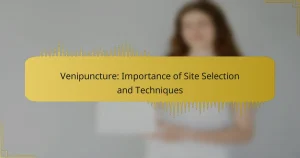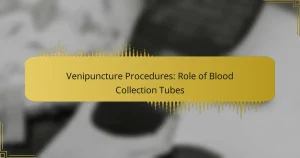Venipuncture Certification Exam: Preparation Tips and Resources
Preparing for the Venipuncture Certification Exam in Canada requires a strategic approach that combines study materials, practice exams, and hands-on training. By utilizing online courses, textbooks, and video tutorials, you…
Continuing Education in Venipuncture: Benefits for Healthcare Professionals
Continuing education in venipuncture is essential for healthcare professionals seeking to enhance their skills and improve patient outcomes. By engaging in ongoing training, practitioners can stay current with the latest…
Hematoma Formation: Identification and Management
Hematoma formation occurs when blood accumulates beneath the skin or within tissues, often resulting from trauma or underlying medical conditions. Early identification through visual assessment, palpation, and imaging is crucial…
Venipuncture: Obesity Challenges, Techniques and Solutions
Venipuncture in obese patients poses distinct challenges due to anatomical variations and increased tissue density, making vein location more difficult and raising the risk of complications. To improve success rates,…
Venipuncture Techniques: Choosing the Right Method for Oncology Patients
Venipuncture techniques for oncology patients require careful consideration of various factors, including the patient’s medical condition and treatment plan. Methods such as peripheral venipuncture, central venous access, and ultrasound-guided approaches…
Venipuncture: Common Mistakes and How to Avoid Them
Venipuncture is a critical procedure in healthcare, but common mistakes can lead to complications and patient discomfort. Issues such as improper site selection, inadequate patient preparation, and incorrect needle angles…
Venipuncture Techniques: Strategies, Tools and Approaches for Difficult Veins
Venipuncture can be particularly challenging when dealing with difficult veins, but effective techniques and strategies can enhance the success of blood draws. By utilizing specialized tools such as vein finders…
Infection Risks: Evaluation in Venipuncture
Venipuncture is a common medical procedure that, while necessary, carries inherent infection risks such as skin infections and exposure to bloodborne pathogens. To safeguard patient safety, healthcare providers must be…
Venipuncture Tourniquets: Options and Recommendations
Venipuncture tourniquets are essential tools for healthcare professionals, designed to temporarily restrict blood flow and enhance vein visibility during blood draws. In Canada, the best options prioritize comfort, ease of…
Venipuncture: Geriatric Considerations, Techniques and Best Practices
Venipuncture in geriatric patients requires careful consideration of their unique physiological changes, which can complicate the procedure and increase discomfort. Employing specialized techniques, such as using smaller gauge needles and…






